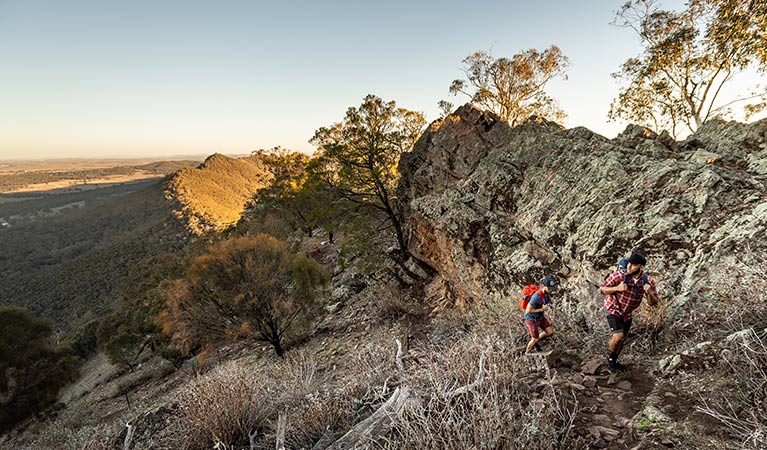The Rock Nature Reserve - Kengal Aboriginal Place
Overview
The Rock Nature Reserve - Kengal Aboriginal Place offers scenic picnic spots, walking opportunities, picnicking, birdwatching and rock climbing, close to Wagga Wagga.
Read more about The Rock Nature Reserve - Kengal Aboriginal Place
Tucked away in quiet farmland, The Rock Nature Reserve - Kengal Aboriginal Place is a small but diverse haven surrounding a remarkable geological giant: The Rock, soaring 364m above the plains.
There are things to do for every type of traveller at the reserve. Take the family and find a relaxing picnic spot, or if you’re an avid adventurist, have a go at rock climbing with friends. Hikers looking for something short, vigorous, and with a big scenic view at the finish line will also appreciate the reserve.
The unique biophysical position of the reserve means it’s filled with varied habitats teeming with everything from turquoise parrots to swamp wallabies. Bring your camera and a pair of binoculars – there’s much to keep them in constant rotation here.
Whether you’re looking for something slow or something adrenaline-filled, the accessibility of The Rock Nature Reserve - Kengal Aboriginal Place makes it an appealing option just down the road from Wagga Wagga. On a clear day, you can even see as far as Mount Kosciuszko and the Victorian Alps.
Local alerts
For the latest updates on fires, closures and other alerts in this area, see https://uat.nswparks.cloud/visit-a-park/parks/the-rock-nature-reserve-kengal-aboriginal-place/local-alerts
Contact
- in the Murray-Riverina region
The Rock Nature Reserve – Kengal Aboriginal Place is always open but may have to close at times due to poor weather or fire danger.
-
-
Tumut Region Visitor Centre
02 6947 7025
Contact hours: 9am to 5pm daily. Closed Christmas Day. - The Old Butter Factory, 5 Adelong Road, Tumut NSW 2720
-
Email: tumutrvc@environment.nsw.gov.au
-
Tumut Region Visitor Centre
Visitor info
All the practical information you need to know about The Rock Nature Reserve - Kengal Aboriginal Place.
Map
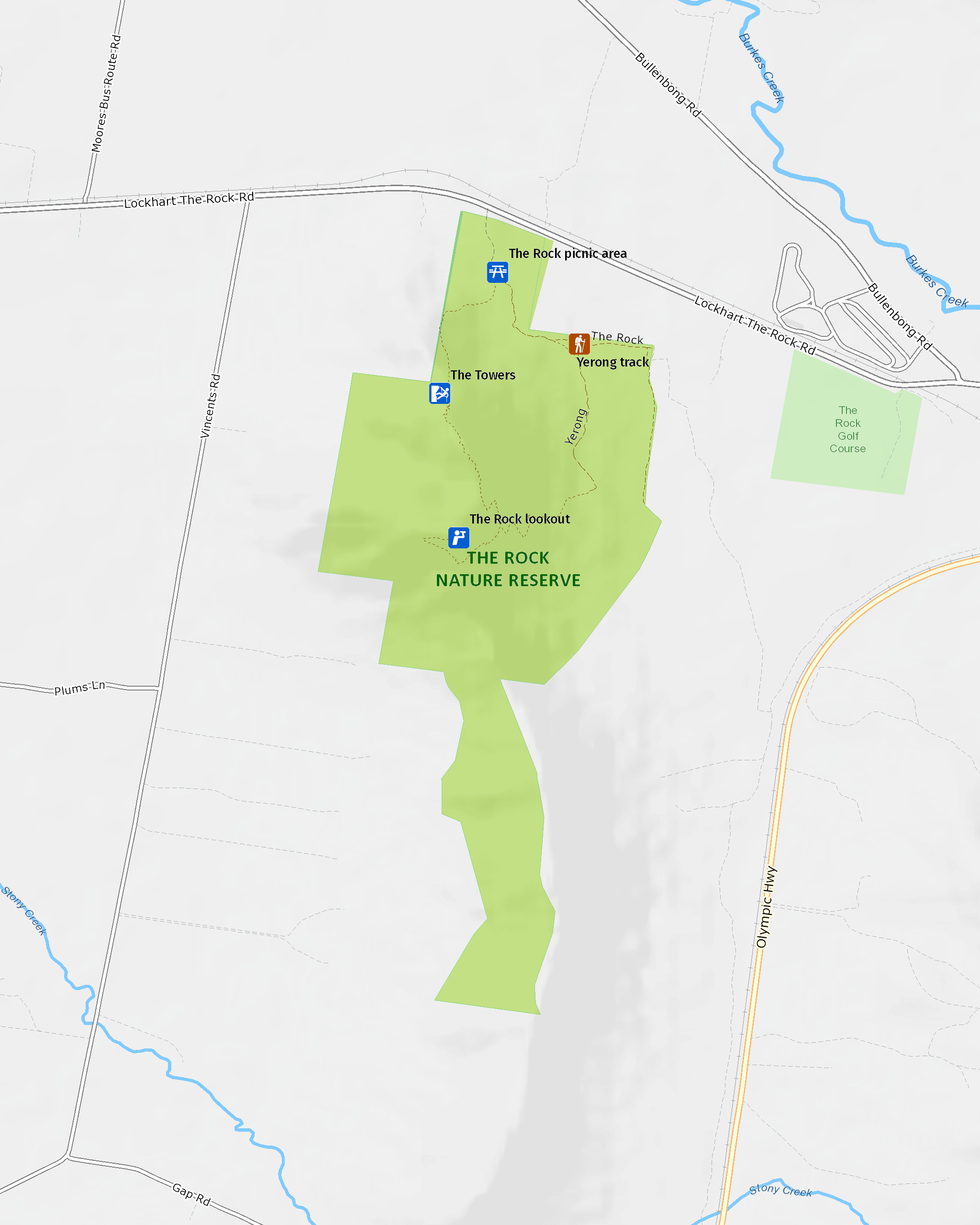
Map legend

Maps and downloads
Nearby towns
Henty (33 km)
Henty is known for its connections with notorious bushranger Dan 'Mad Dog' Morgan. It's also where Headlie Taylor, a citizen of Henty, invented the grain harvester in 1914. Take the Henty Historical Village Walk to learn more about the town's history.
Wagga Wagga (35 km)
Wagga Wagga is renowned for its stunning parks and award-winning gardens. Take a tour through the 20 hectares of themed garden beds in the beautiful Wagga Wagga Botanic Gardens complete with mini zoo and free-flight aviary.
Coolamon (64 km)
Easy walking tracks around Coolamon shire help you discover the abundance of native animals, birds and flora. Don't miss Kindra State Forest and Ganmain's Murumbang Interpretive Walk, where bird-watchers can enjoy spotting up to 200 species of birds.
Learn more
The Rock Nature Reserve - Kengal Aboriginal Place is a special place. Here are just some of the reasons why:
Living Aboriginal culture: Kengal
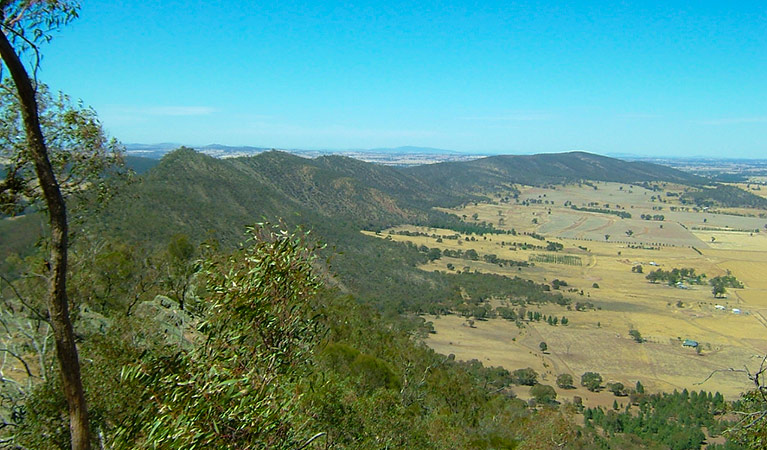
The dual name of the nature reserve (since 2005) acknowledges a Wiradjuri cultural presence that stretches back many generations. The Rock is also known as Kengal (meaning ‘sloping hill’), a Dreaming place, lookout, and ceremonial site for the Wiradjuri People and their descendants. It was once used for male initiation rituals. Traditional lore has it that Kengal was created by Baiame, the creator who also taught the Wiradjuri People how to make fire and spears. When settlers arrived in the area, stories go, Baiame left his male and female dingo (Mirrigan) companions, who lay in wait for Baiame’s return, forming The Rock.
- Aboriginal special places guided tours Join Bundyi Cultural Tours in The Rock Nature Reserve - Kengal Aboriginal Place, near Wagga Wagga to explore ancient Wiradjuri culture in a beautiful and timeless landscape.
Geological significance
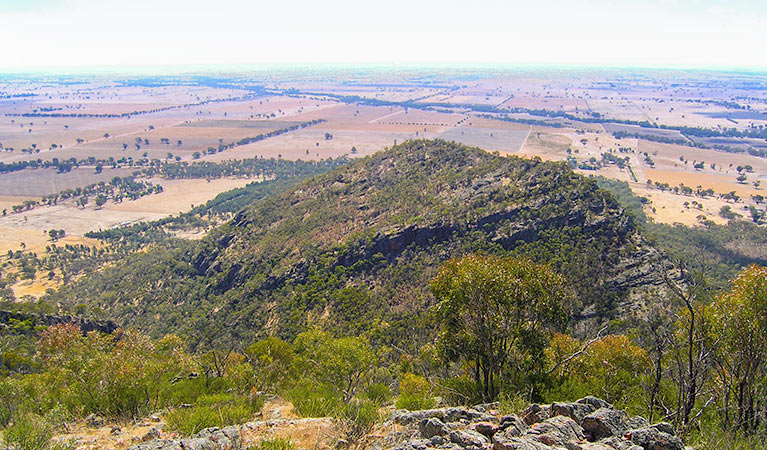
The reserve sits on the boundary between two major biophysical regions: the Riverine Plains and the western slopes of the Eastern Highlands. This geographic mix gives the area a terrific diversity of landscapes and animal habitats. The Rock itself, unique in the district, is the result of a pressure uplift of sedimentary materials, and is the highest point of a hogback ridge running north to south (The Rock is at the northern end). The summit stands 364m above the surrounding plains.
- Aboriginal special places guided tours Join Bundyi Cultural Tours in The Rock Nature Reserve - Kengal Aboriginal Place, near Wagga Wagga to explore ancient Wiradjuri culture in a beautiful and timeless landscape.
- The Towers The Towers is a 100m stretch of the north-east face of The Rock, open to rock sports and also popular with photographers and birdwatchers who want to view peregrine falcons.
'The Hanging Rock’
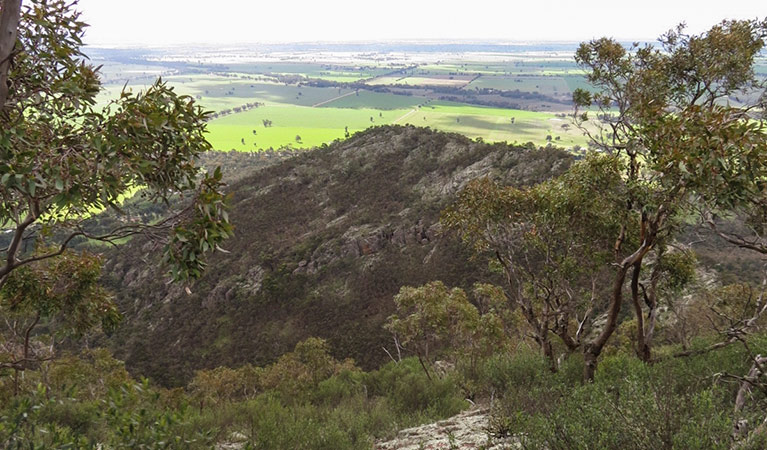
Charles Sturt first saw The Rock in 1829, though the area wasn’t settled further by Europeans until 1874. They called the remarkable geological feature ‘The Hanging Rock’ because of an overhang on its eastern face. This collapsed in 1874, however, leading to the adoption of its current name – simply, ‘The Rock’. For much of its modern life, the feature has sat on Crown land, and from 1891 its lower slopes were quarried for road base material to provide ballast on a Sydney-Melbourne rail line.
Education resources (1)
What we're doing
The Rock Nature Reserve - Kengal Aboriginal Place has management strategies in place to protect and conserve the values of this park. View the detailed park and fire management documents.

